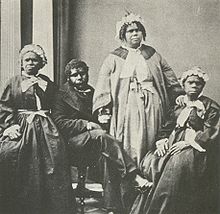Truganini c. 1812 – 8 May 1876 was a woman widely considered to be the last full blood Aboriginal Tasmanian (Palawa).
There are a number of other spellings of her name, including Trugernanner, Trugernena, Trugannini, Trucanini, Trucaminni, and Trucaninny. Truganini was also widely known by the nickname Lalla(h) Rookh.
Truganini was born in 1812 on Bruny Island, south of the Tasmanian capital Hobart, and separated from the Tasmanian mainland by the D'Entrecasteaux Channel. She was a daughter of Mangana, Chief of the Bruny Island people. Her name was the word her tribe used to describe the grey saltbush Atriplex cinerea. Before she was 18, her mother had been killed by whalers, her first fiance had died while saving her from abduction, and in 1828, her two sisters, Lowhenunhue and Maggerleede, had been abducted and taken to Kangaroo Island, off South Australia and sold as slaves. Truganini married Woorrady, although he died when she was still in her 20s.
When Lieutenant-Governor George Arthur arrived in Van Diemen's Land in 1824, he implemented two policies to deal with the growing conflict between settlers and the Aborigines. First, bounties were awarded for the capture of Aboriginal adults and children, and secondly an effort was made to establish friendly relations with Aborigines in order to lure them into camps. The campaign began on Bruny Island where there had been fewer hostilities than in other parts of Tasmania.
In 1830, George Augustus Robinson, the Protector of Aborigines, moved Truganini and Woorrady to Flinders Island with the last surviving Tasmanian Aborigines, numbering approximately 100. The stated aim of isolation was to save them, but many of the group died from influenza and other diseases. Truganini also helped Robinson with a settlement for mainland Aborigines at Port Phillip in 1838. After about two years of living in and around Melbourne they became outlaws, stealing from settlers around Dandenong before heading to Bass River and then Cape Paterson where members of their group murdered two whalers at Watsons hut then shot and injured other settlers around the area. A long pursuit followed where those responsible for the murders were captured, sent for trial then hanged in Melbourne. A gunshot wound to Truganini's head was treated by Dr. Hugh Anderson of Bass River before she and her party were sent to stand trial in Melbourne, resulting in her being sent back to Flinders Island. In 1856, the few surviving Tasmanian Aborigines on Flinders Island, including Truganini, were moved to a settlement at Oyster Cove, south of Hobart.
Truganini is often considered to be the last full-blood speaker of a Tasmanian language. The Companion to Tasmanian History details three full blood Tasmanian Aboriginal women, Sal, Suke and Betty, who lived on Kangaroo Island in South Australia in the late 1870s and 'all three outlived Truganini.' There were also Tasmanian Aborigines living on Flinders and Lady Barron Islands. Fanny Cochrane Smith (1834–1905), outlived Truganini by 30 years and in 1889 was officially recognised as the last full blooded Tasmanian Aboriginal. Smith recorded songs in her native language, the only audio recordings that exist of an indigenous Tasmanian language.
In 1997 the Royal Albert Memorial Museum, Exeter, England, returned Truganini's necklace and bracelet to Tasmania. In 2002, some of her hair and skin were found in the collection of the Royal College of Surgeons of England and returned to Tasmania for burial.











































No comments:
Post a Comment